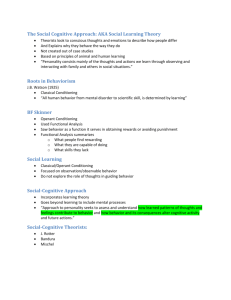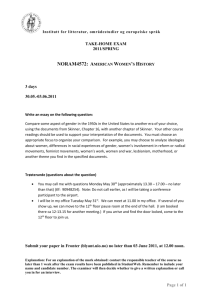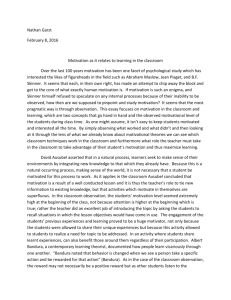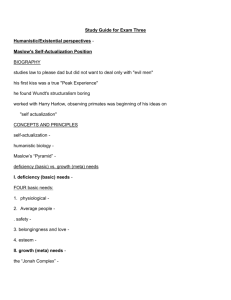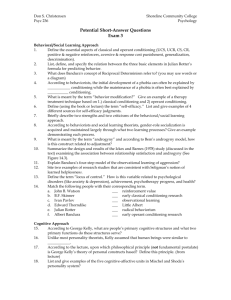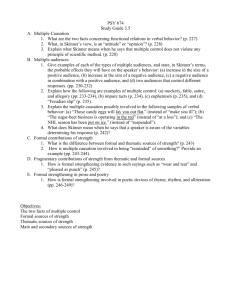AP Psychology
advertisement
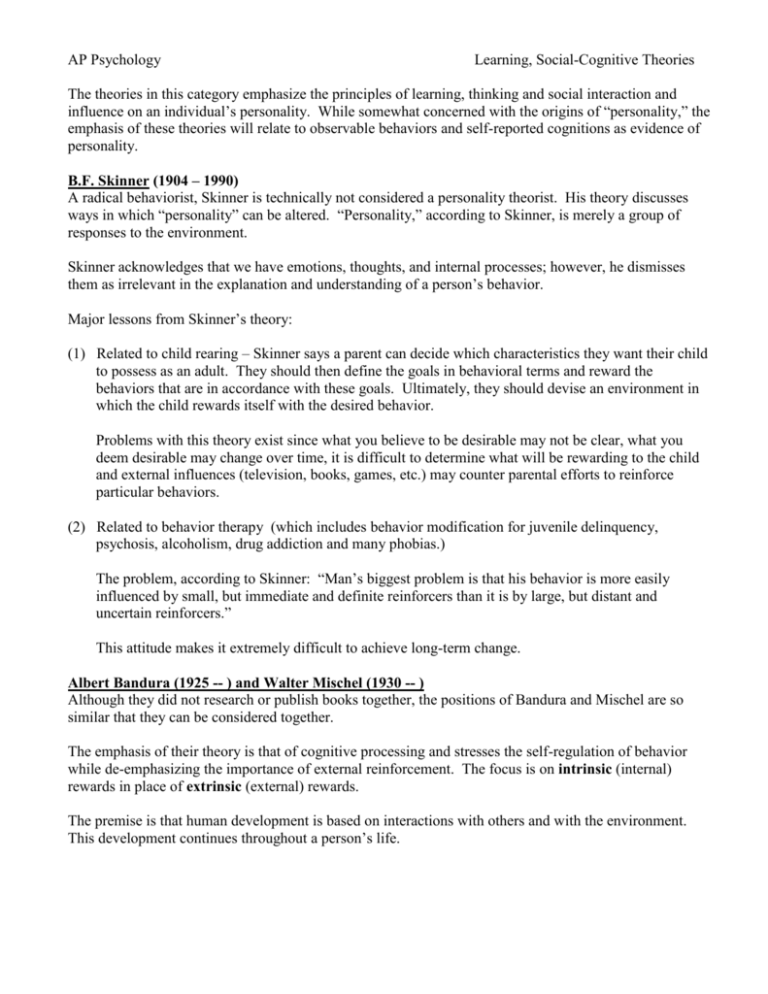
AP Psychology Learning, Social-Cognitive Theories The theories in this category emphasize the principles of learning, thinking and social interaction and influence on an individual’s personality. While somewhat concerned with the origins of “personality,” the emphasis of these theories will relate to observable behaviors and self-reported cognitions as evidence of personality. B.F. Skinner (1904 – 1990) A radical behaviorist, Skinner is technically not considered a personality theorist. His theory discusses ways in which “personality” can be altered. “Personality,” according to Skinner, is merely a group of responses to the environment. Skinner acknowledges that we have emotions, thoughts, and internal processes; however, he dismisses them as irrelevant in the explanation and understanding of a person’s behavior. Major lessons from Skinner’s theory: (1) Related to child rearing – Skinner says a parent can decide which characteristics they want their child to possess as an adult. They should then define the goals in behavioral terms and reward the behaviors that are in accordance with these goals. Ultimately, they should devise an environment in which the child rewards itself with the desired behavior. Problems with this theory exist since what you believe to be desirable may not be clear, what you deem desirable may change over time, it is difficult to determine what will be rewarding to the child and external influences (television, books, games, etc.) may counter parental efforts to reinforce particular behaviors. (2) Related to behavior therapy (which includes behavior modification for juvenile delinquency, psychosis, alcoholism, drug addiction and many phobias.) The problem, according to Skinner: “Man’s biggest problem is that his behavior is more easily influenced by small, but immediate and definite reinforcers than it is by large, but distant and uncertain reinforcers.” This attitude makes it extremely difficult to achieve long-term change. Albert Bandura (1925 -- ) and Walter Mischel (1930 -- ) Although they did not research or publish books together, the positions of Bandura and Mischel are so similar that they can be considered together. The emphasis of their theory is that of cognitive processing and stresses the self-regulation of behavior while de-emphasizing the importance of external reinforcement. The focus is on intrinsic (internal) rewards in place of extrinsic (external) rewards. The premise is that human development is based on interactions with others and with the environment. This development continues throughout a person’s life. The process of interacting with the environment is called reciprocal determinism, which states that the individual, the environmental situation, and the person’s emotions and cognitions all interact to influence one another. Bandura and Mischel spoke of self-efficacy: believing (or not believing) “that one can organize and execute given courses of action required to deal with prospective situations.” (Bandura, 1977) Whether a person demonstrates high self-efficacy (self-confidence) or low self-efficacy depends upon his/her past experiences and the consequence that resulted from particular choices. Bandura (of Bobo doll fame) developed a four-step pattern to explain influences on behaviors: (1) (2) (3) (4) attention – the individual notices something in the environment retention – the individual remembers what was noticed reproduction – the individual processes an action that is a copy of what was noticed motivation – the environment delivers a consequence that changes the probability that the behavior will be emitted again in the future (Think of the Bobo doll example – the child noticed the doll getting “socked”; he remembers that event; he is able to copy the action when exposed to a Bobo doll; when he saw the model “praised” for such Bobo bashing, he repeated the behavior in anticipation of his own praise.) Julian Rotter (1916 --) Julian Rotter lived comfortably with his family until his father lost his job during the Great Depression. This dramatic change made him more aware of social injustice and showed him how situational conditions affect personality and behavior. Rotter studied the writings of Freud and Adler and was greatly influenced by psychoanalysis; however, his theory departs dramatically from psychoanalysis and from drive-based behaviorism. His theory emphasizes the interaction of the individual with the environment. According to Rotter, in order to understand a person’s personality, you have to consider both the individual (his past history and learning experiences) and the environment. His empirical law of effect states that people are motivated to seek out positive reinforcement while avoiding negative consequences. The Components of his Social Learning theory model: Behavior potential is the likelihood that a behavior or emotion will occur in a particular situation. Expectancy is the probability that a given behavior will lead to a particular outcome (based on experience) Reinforcement value is the individual’s subjective preference for one reinforcer over others. For example, when your brother takes something of yours without permission, then each possible behavior has a behavior potential. Maybe you will: yell at him, hit him, or tell your mother. The expectancy of each behavior depends upon what may have happened in the past (yelling at him may get him to give it back, hitting him will get you in trouble, telling your mother may get her angry at you for bothering her.) The reinforcement value depends upon the individual (yelling may result in the least negative consequence so it may be what happens, or hitting him may get you in trouble but it may make you feel so good that the punishment is overridden by the delight – not that anyone is condoning this, by the way.) Rotter is also known for his concept of locus of control, or what people believe causes them to get reinforcements in life. People with an internal locus of control believe that success or failure is due to their own efforts, while people with an external locus of control believe that life is controlled by luck, chance or powerful others and not by the things they do. Rotter developed a measurement instrument called the Incomplete Sentences Blank (ISB). It is a projective technique used to determine adjustment in high schoolers, college students and adults. Some examples: I enjoy __________________________________________ My friends _______________________________________ John Dollard (1900 -- 1980) and Neal Miller (1909 -- 2002 ) Dollard and Miller were colleagues at Yale and both had received psychoanalytic training in Europe prior to their affiliation in the US. Clearly influenced by Freud, Dollard and Miller were also greatly influenced by drive theorist Clark Hull and BF Skinner. Some of the basics of Hull’s drive theory of motivation: A drive is any stimulus or need that evokes a behavior to reduce or eliminate it (for example, hunger) A cue is an environmental stimulus that a person notices (for example, a hot fudge sundae) A response hierarchy is a set of different responses to the cue that would reduce the drive (ex. grab the sundae, eat a carrot) Reinforcement is anything that will reduce the drive (ex. eating something will be reinforcing) Stages of Development (compare with Freud) (These critical training periods are when the developing child must learn certain principles and resolve certain conflicts. They must happen in order but are not bound to occur at any particular age.) Feeding – based on the hunger drive and hunger reduction Responses that are reinforced are strengthened (e.g., crying) and emotional reactions associated with responses also increase (e.g., love and security vs. apathy and worry.) If punishment is associated, the child may experience drive conflict and anxiety Cleanliness Training – associated with toilet training What is learned and how during this stage determines whether the child acquires feelings such as anxiety, guilt, conformity, and anger or more positive feelings about self, parents and others. May result in approach-avoidance conflict (see back) Early-sex Training – sexual impulses begin to emerge The reactions of parents and others to the expression of these emerging drives can lead to conditioned fear/anxiety which may subsequently generalize to other aspects of the individual’s behavior. Dollard and Miller felt that childhood produces many frustrations. In response to frustration, children often express anger overtly by hitting, yelling, throwing things, etc. and generally the result is punishment. They felt this could cause the child to learn to be anxious about feeling anger. They discuss four types of conflicts that people experience in life according to Miller: Approach-approach – the individual is drawn toward two positive choices that can’t both be satisfied (go out with friends or go out with a significant other) Avoidance-avoidance – the individual is repelled by two negative choices (do your homework or clean your room) Approach-avoidance – the individual is drawn toward one goal that is both positive and negative (go out with friends but one in the group is a person you detest) Double approach-avoidance – the individual faces two goals, both of which are both positive and negative (college decision: UVa – good school (+), close to home (-) VaTech – further away (+), bad colors (-) According to Dollard and Miller, most neurotic behavior involves conflict of some variety. They also formulated the frustration-aggression hypothesis: frustration always causes aggression and aggression is always caused by frustration. Consider an example: suppose that you are trying to study because you want a good grade (drive) but the room is too noisy (a barrier to the goal, causes you frustration.) The cue-producing response is the anger you feel (this arouses the drive as well, so now you have the original drive and the anger drive to deal with.) Your response hierarchy may include: yelling at your roommate, silently pouting, calling a friend to complain, crying, giving up and going to bed. Which response will you choose? Aggression is likely to be the most drive-reducing, but displaced aggression is also drive-reducing. You will choose the response that has the highest overall reinforcing value.
